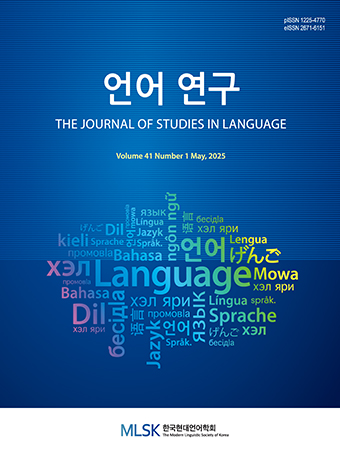Research Article
Abstract
References
Information
This paper focuses on studying the conjunctive and disjunctive coordination of DP phrases in Korean, primarily focusing on the conjunctive meaning derived from DP disjunction phrases coordinated by -(i)na. Conjunction and disjunction are logical operators and when they are used in a natural language, they amount to a meet operator and a join operator respectively. This leads to an assumption that the domains they operate on form a boolean lattice structure, which instantly raises a question regarding the operators' function on the type individuals. Especially, the conjunction of type noun phrases is strongly associated with the issue of plurality and distributivity/collectivity. This paper adopts Winter (2001)'s boolean approach on conjunctive DP phrases, which forms a base for the discussion of the conjunctive meaning from -(i)na disjunction phrases. This paper proposes that -(i)na has only a collective conjunction phrase as its scalar competitor but not a distributive one, which leads to -(i)na phrases' prevalent generation of conjunctive meanings compared to other disjunctive items such as or in English. (University of Ulsan)
- 류병율. 2009. 한국어 접속조사 ‘-이나 (-(이)나)’. 『한국어 의미학』 29, 29-56.
- 류병율. 2013. 한국어 조사 ‘-이나’의 의미와 쓰임. 서울대학교 박사학위 논문.
- 윤재학. 2000. 연접적 ‘이나’. 『언어와 정보』 4.2, 41-54.
- Bennett, M. 1974. Some Extensions of a Montague Fragment of English. Ph.D. Dissertation, University of California, Los Angeles.
- Chierchia, G. 2004. Scalar Implicature, Polarity Phenomena, and the Syntax/pragmatics Interface, in A, Belletti (ed.), Structures and Beyond. Oxford: Oxford University Press.
- Fox, D. 2007. Free Choice and the Theory of Scalar Implicatures, in U. Sauerland and P. Stateva (ed.), Presupposition and Implicature in Compositional Semantics. Basingstoke: Palgrave Macmillan, 71-120.10.1057/9780230210752_4
- Hoeksema, J. 1983. Plurality and Conjunction. In A. ter Meulen (ed.), Studies in Modeltheoretic Semantics. Dordrecht: Foris.
- Hoeksema. J. 1988. The Semantics of Non-boolean and. Journal of Semantics, 6, 19-40.10.1093/jos/6.1.19
- Keenan, E. and L, Faltz. 1985. Boolean Semantics for Natural Language. Dordrecht: D. Reidel.
- Kratzer, A. and J, Shimoyama. 2002. Indeterminate Phrases: the View from Japanese. In Y. Otsu (ed.), The Proceedings of the Third Tokyo Conference on Psycholinguistics. Tokyo: Hituzi Syobo, 1-25.
- Krifka, M. 1990. Boolean and Non-boolean ‘and’. In L. Kalman and L. Polos (ed.), Papers from Second Symposium of Logic and Language. Budapest: Akaemiai Kiado.
- Lasersohn, P. 1995. Plurality, Conjunction and Events. Dordrecht: Kluwer.10.1007/978-94-015-8581-1
- Partee, B. 1987. Noun Phrase Interpretation and Type Shifting Principles. In J. Groenendijk, D. de Jong, M. Stokhof (ed.), Studies in Discourse Representation Theories and the Theory of Generalized Quantifiers. Dordrecht: Floris.
- Partee, B. and M, Rooth. 1983. Generalized Conjunction and Type Ambiguity. In R. Bauerle, C. Schwarz, and A. von Stechow (ed.), Meaning, Use, and Interpretation of Language. Berlin: De Gruyter.10.1515/9783110852820.361
- Sauerland, U. 2004. Scalar Implicatures in Complex Sentences. Linguistics and Philosophy 27.3, 367-391.10.1023/B:LING.0000023378.71748.db
- Scha, R. 1981. Distributive, Collective, and Cumulative Quantification. In J, Groenendijk, M, Stokhof, T.M.V. Janssen (ed.), Formal Methods in the Study of Language. Amsterdam: Mathematisch Centrum.
- Schwarzschild, R. 1996. Pluralities. Dordrecht: Kluwer.10.1007/978-94-017-2704-4
- Winter, Y. 2001. Flexibility Principles in Boolean Semantics: The Interpretation of Coordination, Plurality, and Scope in Natural Language. Cambridge, Massachusetts: The MIT Press.
- Publisher :The Modern Linguistic Society of Korea
- Publisher(Ko) :한국현대언어학회
- Journal Title :The Journal of Studies in Language
- Journal Title(Ko) :언어연구
- Volume : 34
- No :3
- Pages :349-362
- DOI :https://doi.org/10.18627/jslg.34.3.201811.349




 The Journal of Studies in Language
The Journal of Studies in Language






